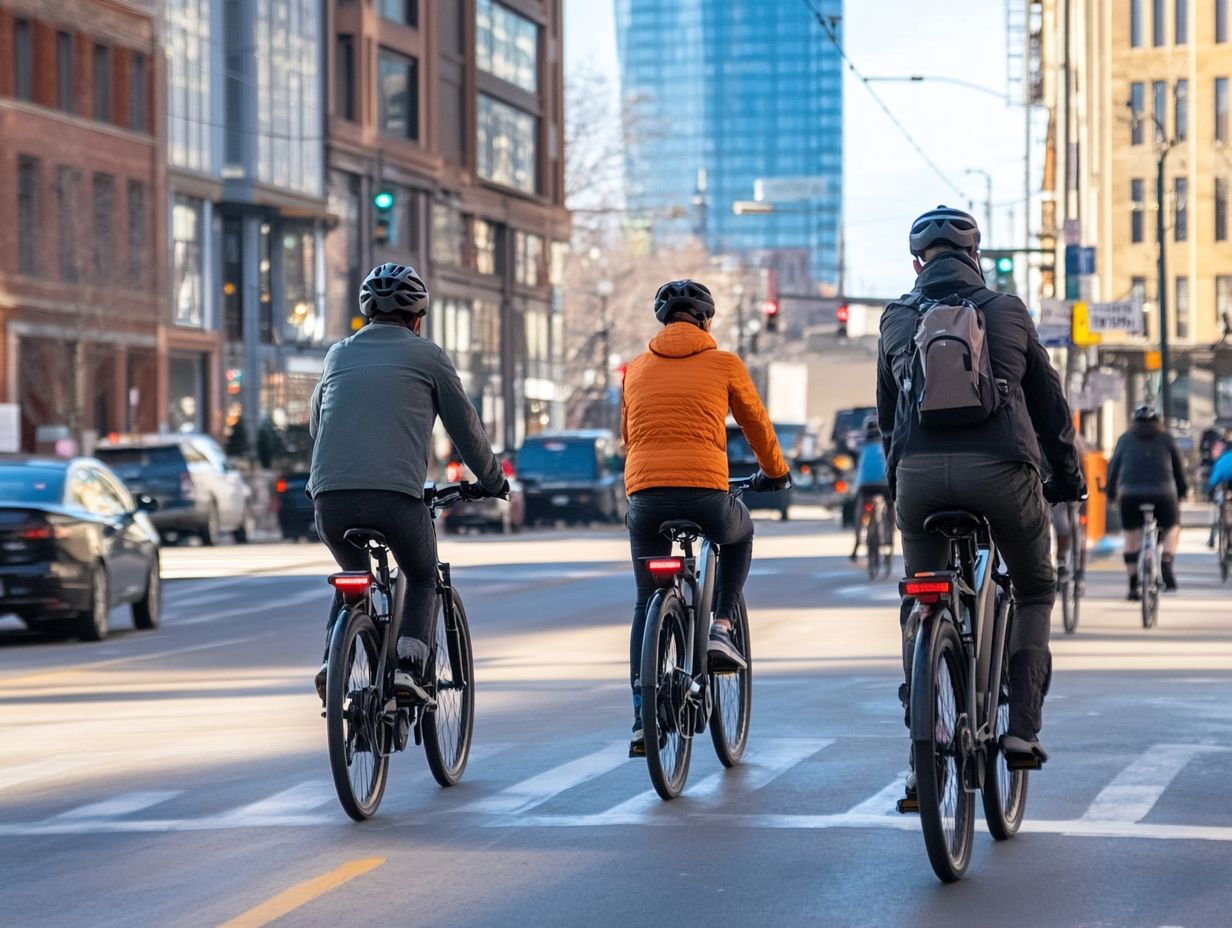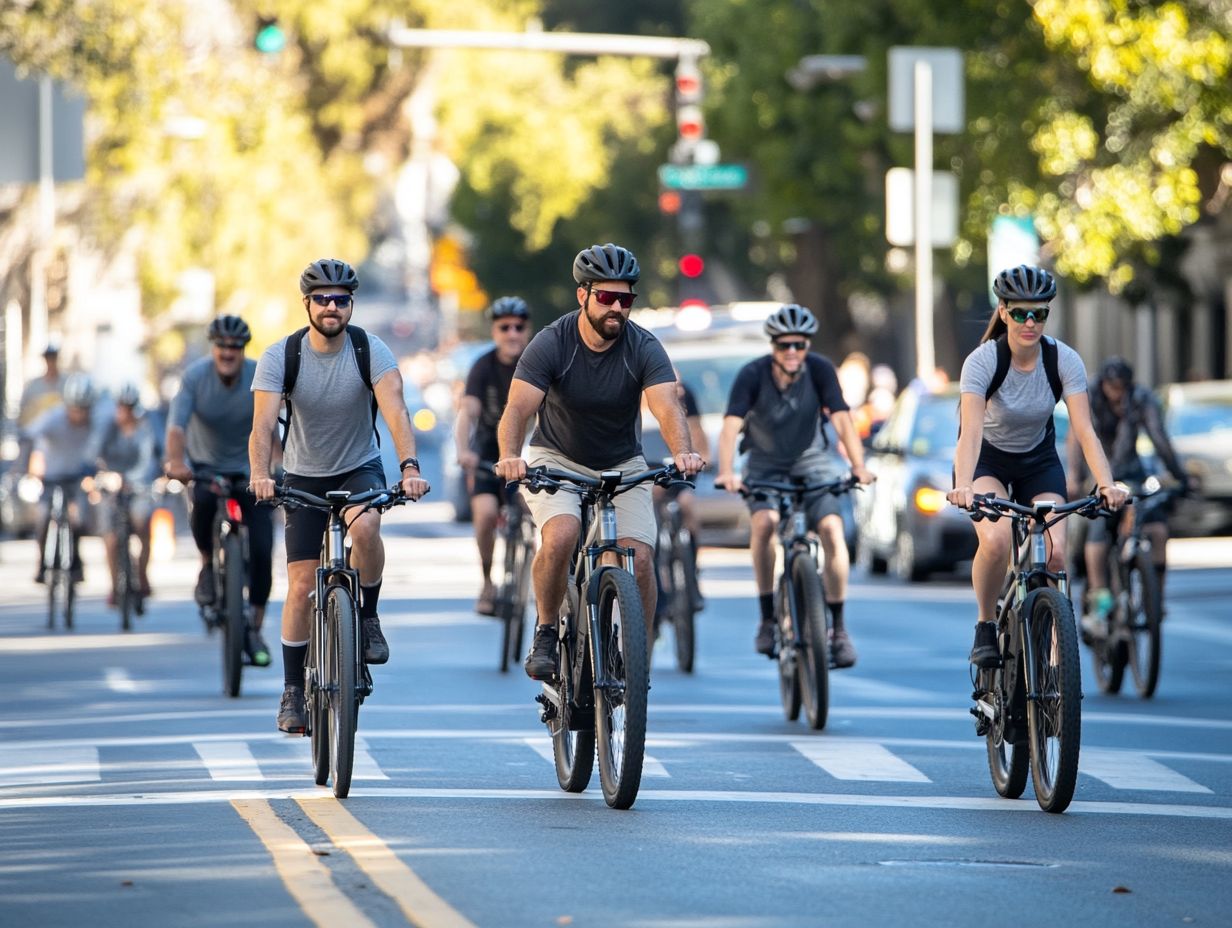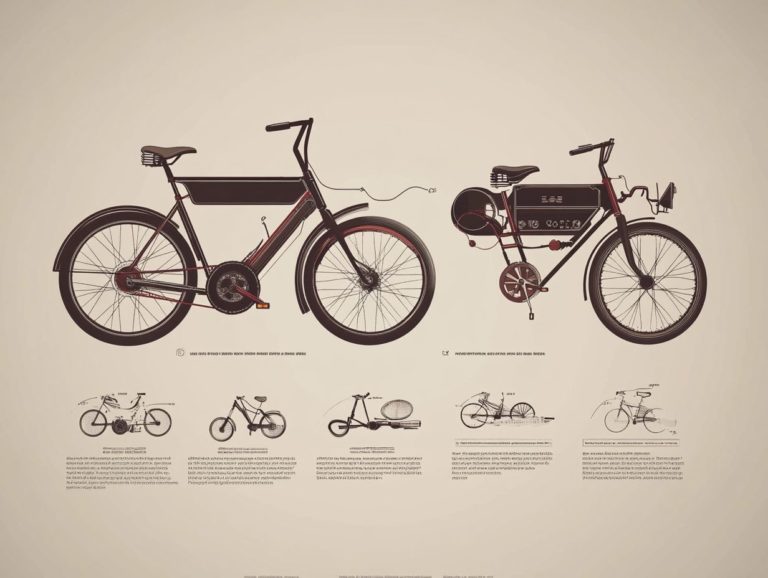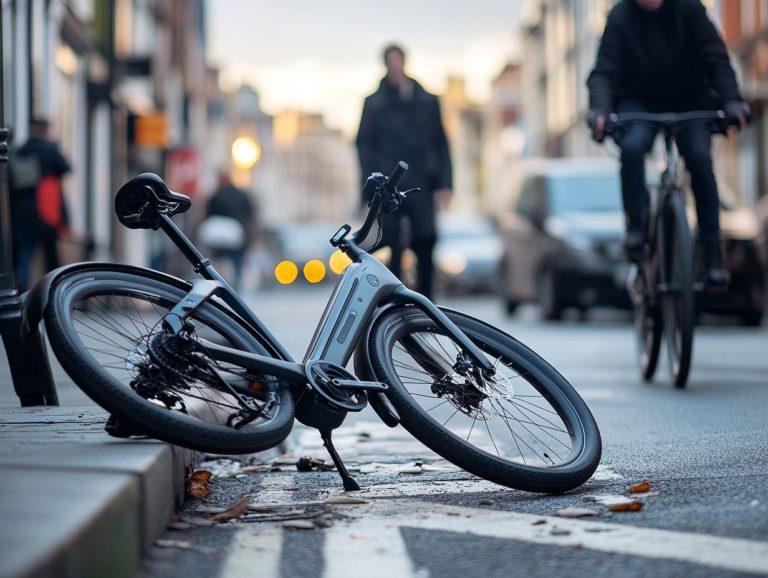The Connection Between Electric Bicycles and Traffic Laws
Electric bicycles, or e-bikes, are revolutionizing how you get around the city, seamlessly combining the benefits of cycling with the convenience of electric power.
As their popularity surges, it becomes increasingly important to understand e-bike laws and how they align with existing traffic regulations.
Let’s explore the different types of electric bicycles: Class 1 e-bike, Class 2 e-bike, and Class 3 e-bike. Each type has its advantages in reducing congestion and emissions while addressing common misconceptions about safety.
You ll find practical tips for riding safely in traffic, ensuring your journey is both smooth and responsible.
Discover how electric bicycles can elevate your commuting experience while staying compliant with California e-bike laws and the rules of the road.
Contents
- Key Takeaways:
- Overview of Electric Bicycles
- Electric Bicycles and Traffic Laws
- Benefits of Electric Bicycles in Traffic
- Common Misconceptions About Electric Bicycles
- Tips for Riding an Electric Bicycle Safely
- Frequently Asked Questions
- 1. What is the connection between electric bicycles and traffic laws?
- 2. Do electric bicycles have to follow the same traffic laws as traditional bicycles?
- 3. Are there any specific traffic laws for electric bicycles?
- 4. Can I ride my electric bicycle on sidewalks?
- 5. Are electric bicycles allowed on bike paths and trails?
- 6. What happens if I break a traffic law while riding my electric bicycle?
Key Takeaways:

- Electric bicycles are legally classified as bicycles, not motor vehicles, and must follow the same traffic laws as traditional bicycles, as outlined in California Assembly Bill No. 1096.
- Electric bicycles can help reduce traffic congestion and emissions, making them a sustainable transportation option for urban areas.
- To ride an electric bicycle safely, it’s important to follow traffic laws and best practices, such as adhering to helmet laws and signaling properly.
Overview of Electric Bicycles
Electric bicycles, or e-bikes, represent a remarkable leap forward in personal transportation, especially with the rise of off-road e-bike options. They effectively combine the eco-friendliness of traditional bicycles with the convenience of electric power.
As you navigate the evolving legal landscape regarding e-bike laws, particularly in California, you’ll encounter various classes Class 1, Class 2, and Class 3 each outlining distinct regulations regarding speed, usage, and safety requirements, including age restrictions and licensing requirements.
These laws help keep riders safe and promote active transportation, encouraging more individuals to adopt this innovative and sustainable mode of travel in accordance with the California Vehicle Code.
Electric Bicycles and Traffic Laws
Understanding the intersection of electric bicycles and traffic laws is essential for your compliance and safety while riding. E-bike regulations differ significantly from one state to another, shaped by the California Vehicle Code and guidelines from organizations like PeopleForBikes and the Consumer Product Safety Commission, which emphasize consumer safety.
These laws encompass critical elements such as helmet mandates, age restrictions, and licensing criteria. Understanding these aspects is vital to navigate the legal landscape with confidence and ensure a smooth ride.
Ready to transform your commute? Try an electric bike today!
Understanding the Legal Classification
The legal classification of electric bicycles plays a crucial role in their use and safety across states, especially under California e-bike laws. In California, e-bikes fall into three classes:
Class 1 e-bikes provide assistance only when you pedal. Class 2 e-bikes come with a throttle for easier rides.
Class 3 e-bikes are designed for higher speeds and have extra regulations. Knowing these classes helps you navigate state regulations and ride safely.
Each class determines where you can ride and what safety standards you must follow. For example, Class 1 e-bikes promote a healthier, eco-friendly way of commuting.
Class 2 e-bikes offer convenience, especially if pedaling feels daunting. Class 3 e-bikes require extra safety gear, like helmets, because of their speed.
By learning about these classifications, you can ensure your rights and comply with the law. This knowledge leads to safer road usage and better riding practices, as per the Consumer Product Safety Commission.
Comparison to Traditional Bicycles

When comparing electric bicycles to traditional ones, several key differences stand out. Traditional bikes rely solely on your pedaling power.
In contrast, electric bikes assist you, making them perfect for hilly terrains or longer commutes in busy cities like New York City.
Regulations for e-bikes differ significantly from those of traditional bicycles. This difference impacts how e-bikes are viewed in transportation policies aimed at promoting eco-friendliness.
Electric bikes make cycling easier for new riders. They invite more people to embrace cycling, especially those worried about personal injury.
From an environmental perspective, e-bikes can reduce emissions, offering a cleaner alternative to cars while keeping the benefits of traditional cycling.
This shift has drawbacks too. You may face higher upfront costs and concerns about battery disposal, sparking questions about sustainability.
As cities recognize the importance of e-bikes, this acceptance reshapes the conversation surrounding sustainable urban mobility in places like Amsterdam and Copenhagen.
Benefits of Electric Bicycles in Traffic
Electric bicycles offer exciting benefits, especially in urban areas facing traffic congestion and pollution. Better bike paths and dedicated lanes can help address these issues.
By encouraging active transportation and providing an eco-friendly car alternative, electric bikes can significantly ease traffic congestion and reduce emissions.
As cities seek sustainable solutions, the advantages of using e-bikes for daily commutes become increasingly clear. They pave the way for more efficient transportation systems and promote active transportation.
Reducing Congestion and Emissions
One of the significant advantages of electric bicycles is their remarkable ability to alleviate congestion and cut down on emissions in urban areas! By offering an alternative mode of transportation, e-bikes help lower greenhouse gas emissions compared to traditional motor vehicles. This perfectly aligns with the goals of many transportation policy initiatives that promote active transportation.
As more people choose e-bikes, cities can enjoy notable enhancements in air quality and reduced travel times! Look at cities like Amsterdam and Copenhagen, where e-bikes have been seamlessly integrated into public transport systems, transforming the urban commuting experience. These regions have established dedicated bike lanes and rental programs to encourage e-bike usage, leading to fewer cars on the road and a decrease in traffic bottlenecks.
These initiatives boost the local economy and create a sustainable urban environment while fostering community engagement in active transportation. As policies continue to adapt, the potential for e-bikes to revolutionize urban transportation and promote eco-friendly habits expands, setting an inspiring example for other cities to emulate, like New York City!
Common Misconceptions About Electric Bicycles
Common misconceptions about electric bicycles can significantly hinder their acceptance and safe usage among potential riders. Many people mistakenly believe e-bikes are inherently dangerous or that they cater only to specific demographics. This can discourage newcomers from exploring this sustainable option.
This kind of thinking fosters unwarranted fears surrounding e-bike safety and the risk of personal injury. In truth, when you follow e-bike regulations and the licensing requirements that govern how e-bikes are used on the road and embrace the safety measures recommended by organizations like the Consumer Product Safety Commission, electric bicycles can offer a safe and enjoyable riding experience for everyone!
Addressing Safety Concerns

Addressing safety concerns tied to electric bicycles means grasping the recommendations from organizations like the Consumer Product Safety Commission and adhering to helmet laws set forth by local regulations. Wearing the right safety gear, including a helmet that complies with California e-bike laws, keeps you safe and reduces your risk of personal injury!
Along with wearing a helmet, consider investing in reflective clothing, gloves, and appropriate footwear to ensure you are maximally protected while riding on bike paths. Being aware of local traffic laws and e-bike-specific regulations is crucial. These rules promote safety on the roads, especially in accordance with California Assembly Bill No. 1096 and can be better understood through understanding electric bicycle laws in California. By complying with these regulations, you decrease the likelihood of accidents and cultivate a sense of responsibility!
Establishing a culture of safety ultimately contributes to a more harmonious coexistence between cyclists and motor vehicles, significantly reducing risks on shared paths and promoting a safer environment for electric bicycles. To ensure you’re informed, check out the top 5 electric bicycle laws every rider should know! Join the movement for safer, eco-friendly travel!
Tips for Riding an Electric Bicycle Safely
Riding an electric bicycle safely requires commitment to best practices. These practices prioritize e-bike safety and compliance with California e-bike laws.
To enjoy a smooth ride, familiarize yourself with regulations governing road riding and bike paths. Understand the features of your e-bike, which can be categorized based on their speed and assistance features.
By following these guidelines, you boost your safety and build a better relationship with other road users.
Following Traffic Laws and Best Practices
Following traffic laws and best practices is crucial for ensuring your safety as an electric bicycle rider. By adhering to local e-bike regulations and understanding the rules of the road, you can significantly reduce risks, especially in busy urban areas where cyclists share space with vehicles.
Respecting bike paths and traffic signals creates a safer environment for everyone on the road.
Keep an eye on speed limits and always yield to pedestrians on shared paths. Make sure to signal your intentions clearly with hand gestures for turns and stops. This small effort goes a long way.
Stay alert for potholes or debris that could disrupt your balance and lead to accidents. Understanding local e-bike laws, such as helmet requirements and where you can ride your e-bike, is equally important. For detailed information, refer to Understanding Electric Bicycle Safety Regulations. Compliance fosters mutual respect between cyclists and motorists, enhancing safety and encouraging a harmonious coexistence on the roads.
Additional Safety Equipment for E-Bikes
Also, along with wearing your helmet, equipping yourself with extra safety gear can significantly boost your protection as an electric bicycle rider. Reflective gear, effective lighting, and signaling devices are essential for making you more visible to others on the road, particularly in low-light conditions or during inclement weather.
By embracing these safety measures, you not only protect yourself but also create a safer environment within the e-bike community.
You should also consider adding reflective vests or armbands, especially beneficial in urban settings where streetlights may not illuminate every path. High-quality front and rear lights are necessary; they enhance your visibility and alert drivers to your presence. Using handlebar or helmet-mounted lights provides you a 360-degree view, ensuring no blind spots.
Furthermore, opting for brightly colored clothing can further enhance your visibility, making you stand out even in crowded areas. Together, these elements form a comprehensive safety strategy, enabling you to navigate urban landscapes with greater confidence and reduced risk.
Frequently Asked Questions

1. What is the connection between electric bicycles and traffic laws?
The connection between electric bicycles and traffic laws is that electric bicycles are considered vehicles under traffic laws and are subject to the same rules and regulations as traditional bicycles and other motor vehicles.
2. Do electric bicycles have to follow the same traffic laws as traditional bicycles?
Yes, electric bicycles are considered bicycles under traffic laws. Therefore, they must follow the same traffic laws as traditional bicycles, such as stopping at stop signs, obeying traffic signals, and riding in designated bicycle lanes.
3. Are there any specific traffic laws for electric bicycles?
Yes, some states and countries have specific traffic laws for electric bicycles, such as maximum speed limits and age restrictions for riders. It is important to check your local laws and regulations regarding electric bicycles before riding.
4. Can I ride my electric bicycle on sidewalks?
The rules for riding electric bicycles on sidewalks vary depending on the location. In most cases, electric bicycles are not allowed on sidewalks and must be ridden on the road or in designated bicycle lanes. It is important to check your local laws and regulations regarding electric bicycles and sidewalks.
5. Are electric bicycles allowed on bike paths and trails?
Whether electric bicycles are allowed on bike paths and trails depends on the location. Some paths permit them, while others have restrictions.
Always check the specific rules before riding your electric bicycle. So, before you head out, make sure you know the rules! It’s better to be safe than sorry.
6. What happens if I break a traffic law while riding my electric bicycle?
If you break a traffic law while riding your electric bicycle, you might face penalties similar to those for traditional bicycles or motor vehicles. This can include fines, points on your license, or even having your electric bicycle taken away by authorities.
Following traffic laws is essential to avoid these consequences.





